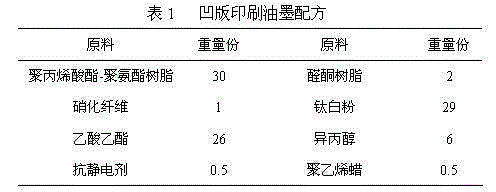Preparation method of polyacrylate-polyurethane resin for printing ink
A technology of polyacrylate and polyurethane resin, which is applied in the field of preparation of polyacrylate-polyurethane resin for gravure printing ink, which can solve the problems such as the influence of resin performance, and achieve stable resin performance, good wetting and dispersibility, and good fluidity Effect
- Summary
- Abstract
- Description
- Claims
- Application Information
AI Technical Summary
Problems solved by technology
Method used
Image
Examples
Embodiment 1
[0030] 1) Take 150g of methyl methacrylate, 128g of n-butyl acrylate, 23.2g of hydroxyethyl acrylate, 2.16g of acrylic acid, 2.84g of glycidyl methacrylate, and add them into the reactor together with 200g of ethyl acetate, stir and heat up to 69°C, uniformly add an initiator solution consisting of 4.7g of azobisisobutyronitrile and 200g of ethyl acetate to the reactor within 3 hours for free radical polymerization, continue the reaction for 3 hours after the addition, and then add 0.5g of azobisisobutyronitrile Azodiisobutyronitrile, 171.6g ethyl acetate and 142.9g isopropanol were reacted for another 2 hours, and the polyacrylate resin with epoxy groups was obtained after cooling down, with a solid content of 30wt%, a number average molecular weight of 16115, and a glass transition The temperature is 8°C.
[0031] 2) Mix 250g of vacuum-dried polyneopentyl glycol adipate (number average molecular weight 2000) with 52.7g of isophorone diisocyanate and 0.025g of dibutyltin dila...
Embodiment 2
[0034] 1) Take 125g of methyl methacrylate, 92g of 2-ethylhexyl acrylate, 13g of hydroxyethyl methacrylate, 1.29g of methacrylic acid, 2.13g of glycidyl methacrylate, and add them together with 152g of ethyl acetate In the reactor, stir and raise the temperature to 69°C. Within 3 hours, uniformly add an initiator solution consisting of 3.6g of azobisisobutyronitrile and 152g of ethyl acetate into the reactor for free radical polymerization reaction. After the addition is complete, continue the reaction for 3 hour, then add 0.4g azobisisobutyronitrile, 131.7g ethyl acetate and 108.9g isopropanol, react for 2 hours again, cool down to get the polyacrylate resin with epoxy group, solid content 30wt%, several The average molecular weight is 15561, and the glass transition temperature is 9°C.
[0035]2) Mix 180g of vacuum-dried polyneopentyl glycol adipate (number average molecular weight 2000) with 40g of isophorone diisocyanate and 0.018g of dibutyltin dilaurate, and heat up to 6...
Embodiment 3
[0038] 1) Take 172g of vinyl acetate, 100g of ethyl acrylate, 43.2g of hydroxypropyl methacrylate, 3.44g of methacrylic acid, 1.42g of glycidyl methacrylate, and put them into the reactor together with 209g of ethyl acetate, stir and raise the temperature To 73°C, uniformly add an initiator solution consisting of 3.5g of azobisisobutyronitrile and 209g of ethyl acetate to the reactor within 3 hours for free radical polymerization, continue the reaction for 3 hours after the addition, and then add 0.34g Azobisisobutyronitrile, 179.5g ethyl acetate and 149.4g isopropanol were reacted for another 2 hours, and the temperature was lowered to obtain a polyacrylate resin with epoxy groups, with a solid content of 30wt%, a number average molecular weight of 26013, and vitrification The transition temperature is 13°C.
[0039] 2) Mix 250g of vacuum-dried polypropylene glycol (number-average molecular weight 2000) with 50g of isophorone diisocyanate and 0.037g of dibutyltin dilaurate, a...
PUM
| Property | Measurement | Unit |
|---|---|---|
| glass transition temperature | aaaaa | aaaaa |
| amine value | aaaaa | aaaaa |
| glass transition temperature | aaaaa | aaaaa |
Abstract
Description
Claims
Application Information
 Login to View More
Login to View More - R&D
- Intellectual Property
- Life Sciences
- Materials
- Tech Scout
- Unparalleled Data Quality
- Higher Quality Content
- 60% Fewer Hallucinations
Browse by: Latest US Patents, China's latest patents, Technical Efficacy Thesaurus, Application Domain, Technology Topic, Popular Technical Reports.
© 2025 PatSnap. All rights reserved.Legal|Privacy policy|Modern Slavery Act Transparency Statement|Sitemap|About US| Contact US: help@patsnap.com


